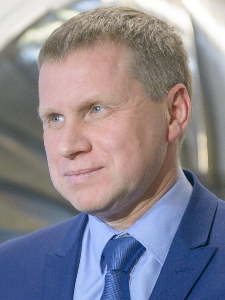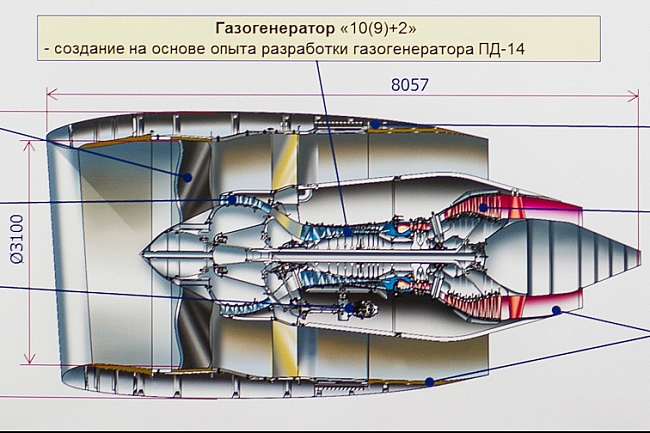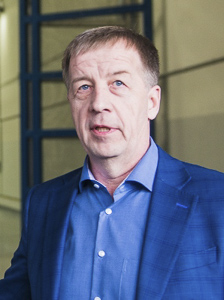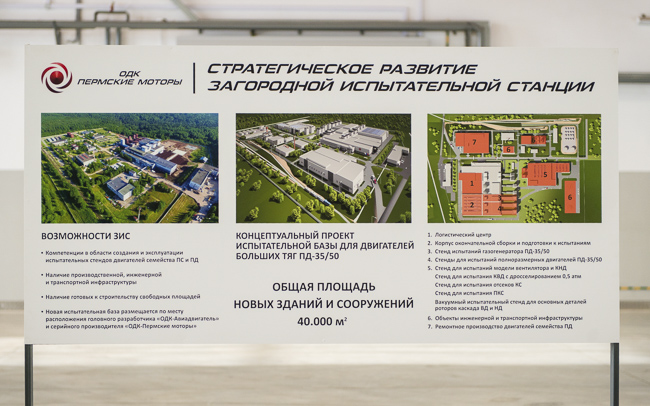
Sergey Popov, Managing Director of the JSC UEC-Perm Engine : "PD-35 is a product, which can be said so that today only the first axial line in the creation of this motor is carried out. First of all, this is the stage of research - research work, which will determine the shape of the engine. At the stage of R & D, the technologies needed to create this engine will also be developed. This is a long long list: fundamentally new materials, which must first be tested in VIAM, CIAM, and only after that decide on the introduction of batch production. Engines of such proportion in the history of the Soviet, Russian aviation have not yet been created. Therefore, a large modernisation, reconstruction of production capacities, not only "UEC-Perm motors", but also other enterprises of the UEC will be required. It is necessary to create a whole test complex, already by 2021-2022 here on the site in Perm.
This will happen in stages. First of all, the designer will create the product. At some point it becomes clear: this is the construct that suits us, let's "run it in iron" and create a prototype. This is approximately 2022 year. And by this time we should already have a test base on which these prototypes could be tested. Most important, it is necessary to begin with tests of the gas generator - the heart of the engine, its hot part. After that, making sure that the correct materials and technical solutions are applied, we will proceed to create a demonstration engine. The engine-demonstrator is going to be built somewhere around 2023. And under this we have to conduct a certain series of tests on the stands on the core processing. There should be a test bench for compressors, a test bench for the combustion chamber ... This is the whole complex that must be created before the very first demonstration engine will be "put into iron".
Despite the fact that the level of applied software products, the level of digitalisation of engine development today is completely different, verification in hardware is still required. The main years just go to this test. I believe that the launch of PD-35 in the series is somewhere around 2028. 10 years to create such an engine is really the period during which you must work systematically, diligently, without relaxing for a minute.

There have to be new materials, including composite ones, a wide range of their applications and their higher level for all characteristics for PD-35. The task is to use Russian components and technologies. Such products should serve as the driving force not only for aircraft engines, but for all industries that work together with us in cooperation. For example, for metallurgists who manufacture iron, plants that later make bearings for us from this iron. It turns out that industrial production in the country as a whole is moving to a new level. The same can be said about the industry of composite materials production. One of the trends that we support in conjunction with VIAM is the creation, for the first time in the history of the Russian aviation industry, of a composite fan blade of a turbine. It is likely that a steel blade will go to the very first sample of PD-35, but we know for sure that the designers are laying the possibility of production with composite blades in this project. In addition, it will be necessary to work out other new technologies, for example, from the use of bolts to switch to rotary welding. It may sound like a stamp, but PD-35 should really be a kind of technological breakthrough that must be implemented in these 10 years.

Director of Infrastructure of UEC-Perm Motors Nikolai Andreev: "This is indeed a very serious project, therefore, the whole country will work on the creation of such an engine - hundreds of enterprises and dozens of scientific institutions. This engine is needed not only for the product itself, but also so that we do not lose our level of competence in the field of engineering design, in the field of technology, in the field of materials, develop and multiply them. This project is really like enormous driving force that will pull the whole economy of the country behind it. As well as PD-14, this engine will be created in wide cooperation with enterprises all over the country, including the UEC.
How to make such an engine? We must understand that by simply scaling the results achieved with the creation of the PD-14 engine, we will only get a part of the required characteristics. The rest of the characteristics we can provide only the development of completely new technologies and new materials. I must say that it is simply impossible to work on R & D without serious investments in production and testing facilities. It is necessary to master new critical technologies, manufacture new materials, create details and units of dimension that have not yet been created in our engine building industry. This requires certain investments.
Our working groups are studying a number of investment projects. In particular, aimed at the development of information systems - this is a large amount of calculations that designers need to do. This requires serious investments in the calculation base here on the territory of "UEC - Aviadvigatel". Large investments are needed to prepare the production base. These are machines and equipment for the production and assembly of high-dimensional parts.
And, of course, the preparation of a test base. Today in the country there is no testing base for finishing and experimental testing of engines of such proportion and such thrust. The bench test base for the creation of this engine will be built on our test station - there will be a logistics center, a body of final assembly and preparation for testing, and a whole set of test benches.

Need to say that not all the nodes of the new engine can be modelled mathematically. We'll still have to manufacture the parts and test them in certain installations, get the result, bring it back and try it again. Therefore, the test base must be created earlier than the engine is created. This is a necessary condition. The fan diameter of PD-35 is 3.1 meters, the diameter of the propulsion system is already approaching 4 meters. This indicates that it is impossible to transport such an engine in assembled form. We assume that we will transport it to the test station by several nodes. By that time, the assembly building will be built. We will collect engines, test, then disassemble, send to aircraft plants, where it will again be assembled directly under the wing of the aircraft.
8 test benches will be built here: nodal stands for testing high-pressure compressors, a test bench for combustion chamber compartments and a full-sized combustion chamber, a vacuum test bed for rotor parts, a closed test bench for a gas generator, two stands and a test room for testing a full-size engine. And an open stand, on which various types of tests will be carried out: acoustic tests, ice casting tests, bird dropping, blade breaks, and so on. The task is to start developing design and estimate documentation this year. The timing of commissioning is very short, so we have very little time. Already, these projects are actively working. "
In conclusion, we can only note some facts. Today, the United Engine-Building Corporation employs more than 90,000 people. The total budget for the PD-35 engine development project is 180 billion rubles, of which 60 billion are investment costs, 120 billion is the creation of the engine itself, including the work of designers and scientific institutions. In the PD-35 project, it is planned to use such promising technologies as:
- application of composite polymer materials in engine parts and assemblies;
- production of large-dimension nacelle from composite materials with laminar flow;
- manufacturing of large-sized and complex-shaped body parts with the use of additive technologies;
- application of new high-temperature alloys and inter-metallic compounds;
- Creation of low-emission combustion chamber.











